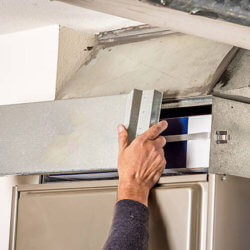
When the cold months roll in, a properly functioning furnace is essential for keeping your home warm and comfortable. However, furnaces can encounter various issues over time, which may disrupt their performance. This guide to furnace repair basics will help you understand common furnace problems, basic troubleshooting steps, and how to maintain your furnace for long-term efficiency. If you’re in the St. Louis area and need professional furnace repair services, Galmiche & Sons is here to assist. Contact our heating and air conditioning experts online or by phone today at 314-993-1110 to learn more.
Common Furnace Problems
Understanding the issues your furnace might face is the first step to identifying and addressing them. Here are some of the most common furnace problems:
1. Furnace Won’t Turn On
This is a frequent issue, especially at the start of the heating season. Potential causes include:
- A tripped circuit breaker
- A faulty thermostat
- Ignition problems
2. Insufficient Heat
When your furnace runs but doesn’t produce enough heat, the problem could stem from:
- Dirty air filters
- Leaky ductwork
- A malfunctioning blower motor
3. Frequent Cycling
If your furnace turns on and off too frequently, it may be due to:
- An incorrectly set thermostat
- Poor airflow
- An oversized furnace for your home
4. Strange Noises
Unusual sounds like banging, rattling, or screeching can indicate:
- Loose components
- A failing motor
- Issues with the burner
5. Pilot Light Issues
A pilot light that won’t stay lit or burns yellow instead of blue may indicate:
- A dirty pilot orifice
- A malfunctioning thermocouple
- Insufficient gas supply

Furnace Repair Basics: Troubleshooting Tips
Before calling a professional for any of the above furnace repair problems, try these simple troubleshooting steps:
- Check the Thermostat: Basic thermostat checks are among the key furnace repair basicsevery homeowner should know. Ensure the thermostat is set to “Heat” and the temperature setting is higher than the current room temperature. Replace the batteries if necessary.
- Inspect the Air Filters: Clogged air filters can restrict airflow and reduce efficiency. Replace filters regularly, typically every 1-3 months. Regular filter changes are a fundamental part of furnace repair basics and preventive care.
- Reset the Circuit Breaker: If the furnace isn’t powering on, check your electrical panel for a tripped breaker and reset it if needed.
- Verify the Pilot Light: If your furnace has a pilot light, ensure it is lit. For electronic ignition systems, consult the manual for resetting instructions.
- Clean Around the Furnace: Dust and debris can interfere with performance. Keep the area around your furnace clean and free of obstructions.
Preventive Maintenance Tips for Furnace Repair Basics
Regular maintenance is key to avoiding costly repairs and ensuring your furnace runs efficiently. Here are some furnace repair and maintenance basics every homeowner should follow:
Schedule Annual Inspections
Professional inspections can catch small issues before they become major problems. Schedule a tune-up before the heating season starts.
Replace Air Filters
Clean filters improve airflow and efficiency. Mark your calendar to replace them regularly.
Clean the Ductwork
Dust and debris in the ductwork can reduce efficiency and air quality. Have ducts professionally cleaned every few years.
Test the Thermostat
Ensure your thermostat is working properly. Consider upgrading to a programmable thermostat for better temperature control and energy savings.
Check for Gas Leaks
For gas furnaces, inspect the connections for leaks. If you smell gas, turn off the furnace, evacuate your home, and contact a professional immediately.
Frequently Asked Questions About Furnace Repair Basics
Why is my furnace blowing cold air?
How often should I replace my furnace filter?
Can I repair my furnace myself?
What’s the average lifespan of a furnace?
Contact Galmiche & Sons for Expert Furnace Repair Services in St. Louis
Dealing with furnace issues can be challenging, but you don’t have to go it alone. At Galmiche & Sons, we’ve provided top-quality heating and cooling services to St. Louis homes and businesses for over 70 years. Whether you need furnace repairs, maintenance, or a new installation, our team is here to help.
Contact us today to schedule your furnace repair service or learn more about our offerings. Let us keep your home warm and cozy all winter long!









